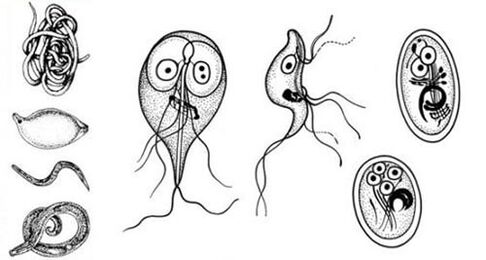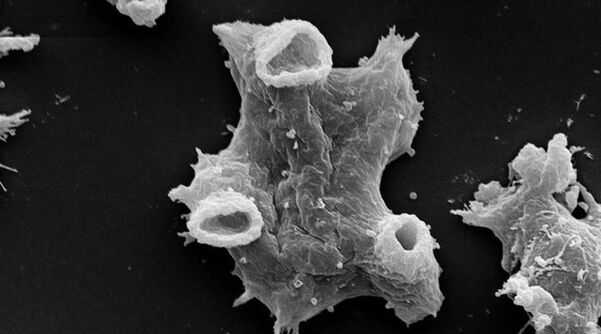It is customary to refer to the parasitic protozoan microorganisms that are constantly present in the human body and consume its "juice". They have nothing to do with worms, but some unicellular parasites can reach large sizes.

They are completely independent organisms, although they have lost their digestive vacuoles, caused by their lifestyle.
Parasite class
Representatives of various organisms can be classified as follows:
- Sarcode- negleria dan amoeba.
- spores- Toxoplasma Plasmodium.
- ciliates- balantidium
- Flagella- Leishmania, Trichomonas, Trypanosomes and Giardia.
This organism was one of the first simple organisms to appear on the planet. The basic structure and function of their work can lead to the development of fatal diseases. The list contains common representatives of protozoan parasites, but there are many more.
Effects on the body
Although these parasites are called protozoa, they have a very negative effect on the human body, causing serious diseases.
Sarcode
amuba dysentery (Entamoedahistolytica).This parasite is most common in hot countries. One feature is the absence of skeletal and shell formation. He has legs for movement. It can form cysts in the human body.
Often causes amoebiasis when the intestinal wall is affected. Someone has loose stools with blood. Diagnosing such amoebae is quite difficult. He is a very dangerous parasite.
Negleria Fowler.Humans are intermediate hosts. The localization of parasites is usually the brain.
Causes amoebic meningoencephalitis, which is often fatal.
Flagella
Trichomonas (Trichmonasvaginalis).The disease occurs in men with almost no symptoms, only in the form of transport. In women, it manifests itself with significant signs of inflammation: profuse discharge with an unpleasant odor, itching and pain in the lower abdomen.
This simplest parasite, as a rule, is transmitted sexually, but it happens that it is also through means of domestic contact. Infected women can infect their babies during childbirth.
Giardia.These microorganisms are parasitic in the gastrointestinal tract. The effects on the body consist of the transport of cysts for many years, but the disease progresses in a mild form. Rarely, it becomes chronic. In this way, they are not afraid of toxic substances and ultraviolet radiation.
spores
Leishmania (Leishaniaspp).This species is localized in almost all human organs and eventually destroys them. Causes a serious disease - visceral leishmaniasis. In their habitat, gaping ulcers form, which constantly rot. It is difficult to treat and often requires surgery.
Plasmodium malaria.It is localized in blood plasma, erythrocytes and liver cells. The worst thing is that this simple organism destroys red blood cells. Leads to tropical malaria and various days. Can seriously damage the kidneys and destroy the nervous system.
Toxoplasma.It affects the lymph nodes and small intestine. Toxoplasmosis often develops, which is very dangerous for pregnant women. In the early stages of infection, it mimics a viral infection.
ciliates
balantidia usus (Balantidiumcoli).Usually affects the large intestine, in particular, the secum. These are relatively large unicellular organisms that are easily incorporated into the blood.
They do not cause much harm to the body, but ulcers can occur in the intestines.
Symptoms and diseases caused by protozoan parasites
Currently, several pathogens have been discovered that cause the following diseases:
- Giardiasis.
- Malaria.
- Leishmaniasis.
- Trichomoniasis.
- Cryptosporidiosis.
- Balantidiasis.
amoebic dysentery
Infection occurs through food and household items.
Symptoms that appear with the course of a mild illness:
- Bloated stomach.
- Cramps in the abdomen.
- Constipation is replaced by diarrhea.
Average severity of disease course:
- Symptomology improved within 10 days.
- There is weakness and loss of appetite.
- Slimy stools with blood.
- A lot of shit.
When the disease becomes chronic, the weight decreases dramatically.
Pathology caused by this parasite:
- Peritonitis.
- Amoebic appendicitis.
- dysentery.
- Lung and liver abscesses.
- Amoebic hepatitis and brain abscesses are very rare.
- Amebiasis of the skin with the development of ulcers and erosions.
With the course of the disease as fast as lightning, even fatal outcomes are possible in the weak.
Naegleria fowleri (Naegleria fowleri)

You can be infected with this parasite when swimming in a pool, as well as through the air.
The disease always begins with the manifestation of acute symptoms:
- Loss of smell and sense of taste.
- Headache and weakness.
- Nausea and urge to vomit.
- Loss of coordination of movement.
- Pulmonary edema may develop.
- Hallucinations and seizures.
It is very difficult to diagnose the disease, so it often ends in the death of the patient.
Negleria cause the following pathologies:
- Amoebic meningoencephalitis.
- Negleriasis.
- Destroys the brain.
- A person often has a coma.
Infections are often fatal.
lamblia
The disease occurs without obvious symptoms. The infection is spread through unwashed fruits and through dirty hands.
Common symptoms:
- Increased salivation.
- Discomfort in the abdomen.
- Loss of appetite and nausea.
Sometimes there is green stool with foam and a pungent odor.
Diseases caused: giardiasis and various intestinal dysfunctions.
Leishmania
Infections caused by mosquitoes.
It comes with severe symptoms:
- Enlargement of the spleen and liver.
- High temperature rise.
- Fever condition.
- Weakness and pale skin.
- Bleeding on the skin.
- Problems with heart activity.
- Anemia and severe weight loss.
Sometimes edema and pneumonia can combine.
These parasites lead to cachexia, decreased muscle tone, impotence and heart failure.
Trichomonas
Infection occurs with free association and hygiene items. Symptoms are mostly absent, but occasionally appear.
For men:
Discomfort during urination.
- There is blood in the semen.
- Whitish whiteness.
Among women:inflammation of the cervix and vagina.
The infection is very dangerous for pregnant women, as it can lead to premature birth.
Plasmodium malaria
Mosquito bites lead to infection.
Plasmodium vivax.Symptoms depend on the stage of the disease:
- Shivering for up to 3 hours - muscle and joint pain, pain in the liver.
- Fever for about 12 hours - temperature up to 40 degrees, decreased pressure, shortness of breath and tachycardia.
- Stage of intense sweating - a sharp drop in temperature with the release of sweat, muscle weakness and hypotension.
Three -day malaria may develop, and spontaneous recovery may occur. There may be enlargement of the spleen, anemia, and sometimes jaundice.
Plasmodium malaria.There are attacks of fever in the morning and evening. Also, there were signs of three-day malaria. Can lead to the development of nephrotic syndrome, which is difficult to treat.
Plasmodium oval.Fever attacks come only in the evening. The disease develops easily, but the liver may be slightly increased.
Toxoplasm
The mode of infection is quite widespread. You can be infected from half -cooked meat, dirty products, blood transfusions and skin cuts. In this way, the infection of pregnant women is often transmitted to the fetus.
With the presence of acute forms of the disease, the following symptoms appear:
- Obvious enlargement of the liver and spleen.
- Signs of jaundice.
- Rash.
- Typical symptoms of meningitis and encephalitis.
- Lymph nodes are enlarged.
In chronic form:
- Long high temperatures.
- Pain in muscles and bones.
- In women, the menstrual cycle is disrupted.
- There are headaches and irritation.
In addition, there may be problems with the thyroid gland and adrenal insufficiency.
Infection with parasites of this class threatens the occurrence of many diseases:
- Oligophrenia.
- Toxoplasmosis.
- epileptic seizures.
- Inflammation of the retina.
- hepatolienal syndrome.
Rarely, but still, lymph node sclerosis occurs.
Balantidia intestine
You can catch parasites through uncooked water, through dirty hands and fruit.
Signs of infection:
- Prolonged diarrhea, with pus and blood.
- Abdominal pain syndrome.
Balantidia leads to the development of peritonitis, organ abscesses and perforation of the intestinal wall.
Conclusion
Infection with protozoa is very similar to infection with viruses. By definition, they are not considered worms, although they cause great harm to human health.
Infection with protozoan parasites can cause death, so when typical symptoms appear, you should immediately seek medical help. Self-medication is strictly prohibited.






































